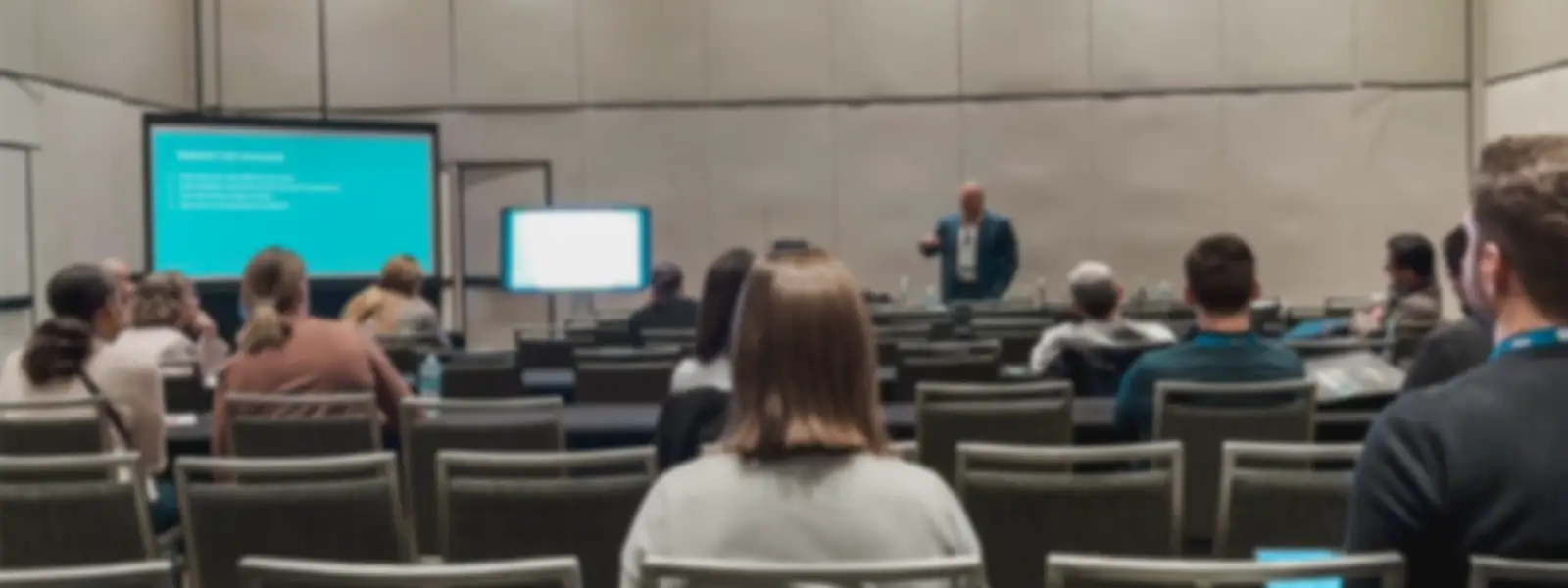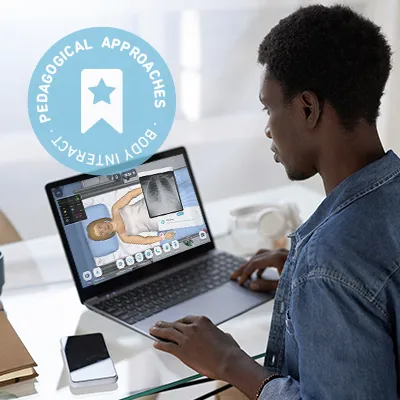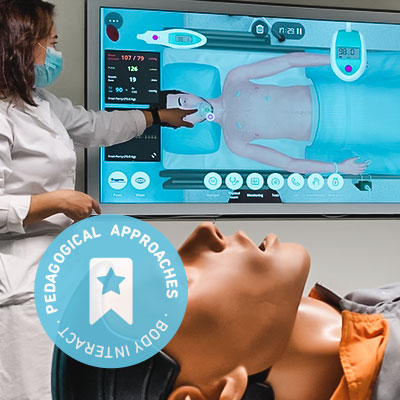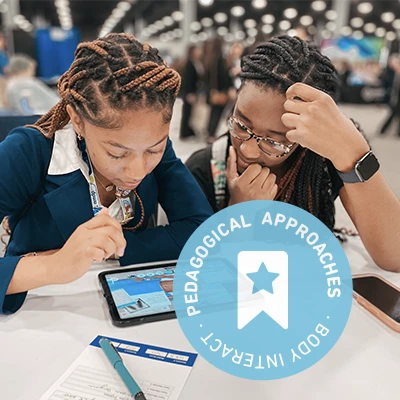Pedagogical Approaches with Body Interact | Team-Audience Hybrid Simulation
In the IMSH 2025, Dr. Michael Spooner and Dr. Matthew Martinez promoted an engaging workshop implementing a new pedagogical approach – Team-Audience Hybrid Simulation (TAHS), in which Body Interact Virtual Patients were the main resource used in the session.
What is Team-Audience Hybrid Simulation?
An innovative learning method that facilitates interactive engagement between a small, dynamic team (microsimulation) and a broader audience (macrosimulation).
Key Aspects of Team-Audience Hybrid Simulation
This approach has some key aspects that differentiate it:
- Audience: The audience actively guides and supports the smaller team by providing expertise, input, and questioning.
- Small team: A small group of participants will act and conduct the clinical actions on the resource of choice for the activity.
- Simulator: The simulation resource used depends on the objectives defined, in this particular case, Body Interact scenarios were used.
- Expert(s): An expert in the area is employed to provide input and additional feedback on the scenario.
- Moderator(s): A knowledgeable moderator organizes the flow of the session, evolving all elements: audience, team, and expert.
How is it conducted?
Before the actual learning experience with TAHS, there is some preparation required, namely:
- Definition of the learning objectives: This important step helps to guide a series of other parts – simulation resource, script curation, expert
- Selection of the simulation resource: Using Body Interact for this purpose can be useful as it allows for all enrolled to explore the scenarios selected; It isn’t resource or logistically demanding; It has a large spectrum of scenarios available in different levels, environments, and specialties.
- Nomination of the small team: This set of elements will engage with the selected simulator/simulation.
- Scripting the case: To ensure the flow, and achieve the learning objectives, it is suggested that the case is to some extent scripted with the team.
- Moderator preparation: The moderator (s) should know the simulation well to understand the different paths it might follow.
- Expert engagement: The expert(s) should be someone with credibility to the audience of the subject matter.
Influenced by the Experiential Learning Theory, from David Kolb, the TAHS unwinds in 5 stages:
1. Setting the stage
– In this step, the moderator should promote psychological safety for the small team and the audience enrolled.
– The moderator should explain the different parts (moderator, small team, expert, and audience) and how it will roll (with pauses for questioning by the different elements and inputs by the expert in certain moments).
2. Clinical scenario presentation
– Brief the small team and the audience on the scenario that will be conducted.
3. Coach the team
– The moderators will kick off the scenario by guiding the small team into and through the scenario. Some coaching may have already occurred before the session to maximize the success of the small group in front of the audience while still allowing the spontaneity and decision-making of the small team.
4. Interact with the audience
– Pause the flow of the simulation in key moments and engage with the audience.
5. Bring in the expert(s)
– Provide opportunities for the experts to provide inputs and engage with the audience.
– To maintain within the line-up defined, the expert input can be used (for example: After a question or comment by the audience that will set the flow off the goals, the moderator could bounce to the moderator by saying something like ‘That is an interesting idea. Expert X is this how you would approach this problem?).
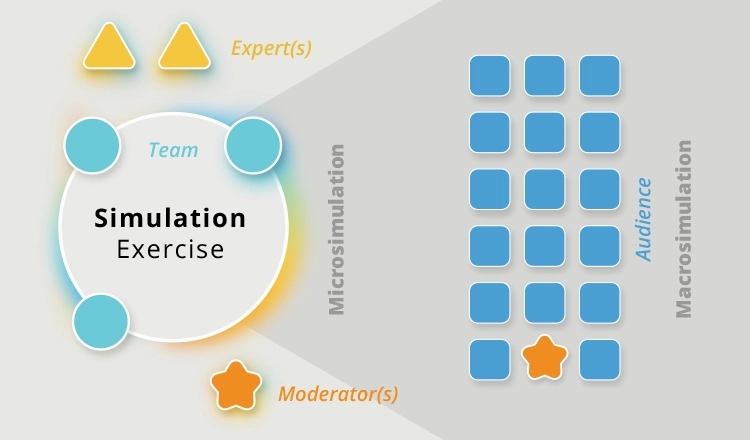
To wrap up, and as with any simulation-based learning experience, a debriefing should be conducted, relating to the pin-point findings of the learning experience and the learning objectives.
What are the benefits of conducting Team-Audience Hybrid Simulation?
- Expert Access: This approach allows for a large audience to have the possibility to receive input and engage with a field expert on the subject
- Scalable: A large cohort of healthcare professionals or students
- Active and Dynamic: How it is designed it enrolls actively learners – audience and the small team – in the learning experience.
- Team-Work Skills: The small team will work as a team while going through Body Interact scenario.
- Flexibility: This pedagogical approach can be implemented in a hybrid approach with the small team in-person and the audience either online or in-person; it can be used both for medicine, nursing, or other healthcare-based professions; it can be used for different levels of the audience, from pre to post-graduate.
Best Practice Suggestions
- Script: To achieve the sessions’ learning goals, the flow of the simulation should be scripted to some extent so that both the moderator and the small team can bring those points to the discussion.
- Moderator preparation: The moderator’s role is crucial, so the moderator should be skilled at creating an engaging and dynamic environment and prepared to make key pauses, ask key questions, and redirect the learning experience to get back on track to achieving the objectives.
- Psychological Safety: It creates an environment where learners feel comfortable making mistakes, asking questions, and engaging in open discussions. It also allows an open flow of information from the audience to and from the team.
- Interactive Inquiry: During TAHS the moderator should promote continuous dialogue, questioning, and reflection between individuals or groups.
- Structured Expertise: In the flow of the TAHS there should be room for the expert(s) to provide structured problem-solving methods to the team/audience.
References
Austin A, et all. COVID-19 educational innovation: Hybrid in-person and virtual simulation for emergency medicine trainees. AEM Educ Train. 2021 Apr 1;5(2):e10593. doi: 10.1002/aet2.10593. PMID: 33786409; PMCID: PMC7995095.
Christian Jarry et al. Distance simulation in surgical education. Surgery. 2025 Jan 8; 180: 109097. PMID: 39787674.
Hayden, EM et al. Mannequin-based Telesimulation: Increasing Access to Simulation-based Education. Acad Emerg Med. 2018 Feb; 25: 144-147. PMID 28846175.
Kolb (1984). Experiential Learning: Experience as the Source of Learning and Development.
Stocker, M. et al. Optimisation of simulated team training through the application of learning theories: a debate for a conceptual framework. BMC Med Educ. 2014 Apr 3; 14:69. PMID: 24694243.
